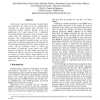Free Online Productivity Tools
i2Speak
i2Symbol
i2OCR
iTex2Img
iWeb2Print
iWeb2Shot
i2Type
iPdf2Split
iPdf2Merge
i2Bopomofo
i2Arabic
i2Style
i2Image
i2PDF
iLatex2Rtf
Sci2ools
FTCS
1996
1996
Experimental Assessment of Parallel Systems
In the research reported in this paper, transient faults were injected in the nodes and in the communication subsystem (by using software fault injection) of a commercial parallel machine running several real applications. The results showed that a significant percentage of faults caused the system to produce wrong results while the application seemed to terminate normally, thus demonstrating that fault tolerance techniques are required in parallel systems, not only to assure that long-running applications can terminate but also (and more important) that the results produced are correct. Of the techniques tested to reduce the percentage of undetected wrong results only ABFT proved to be effective. For other simple error detection methods to be effective, they have to be designed in, and not added as an after thought. Faults injected in the communication subsystem proved the effectiveness of end-to-end CRCs on the data movements between processors.
| Added | 02 Nov 2010 |
| Updated | 02 Nov 2010 |
| Type | Conference |
| Year | 1996 |
| Where | FTCS |
| Authors | João Gabriel Silva, Joao Carreira, Henrique Madeira, Diamantino Costa, Francisco Moreira |
Comments (0)

